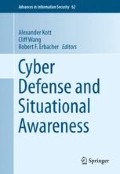Abstract
Having discussed the importance and key features of CSA, both in general and in comparison with a better known Kinetic Situational Awareness, we now proceed to explore how and from where the CSA emerges. Formation of Cyber Situational Awareness is a complex process that goes through a number of distinct phases and produces a number of distinct outputs. Humans with widely different roles drive this process while using diverse procedures and computerized tools. This chapter explores how situational awareness forms within the different phases of the cyber defense process, and describes the different roles that are involved in the lifecycle of situational awareness. The chapter presents an overview of the overall process of cyber defense and then identifies several distinct facets of situational awareness in the context of cyber defense. An overview of the state of the art is followed by a detailed description of a comprehensive framework for Cyber Situational Awareness developed by the authors of this chapter. We highlight the significance of five key functions within CSA: learning from attacks, prioritization, metrics, continuous diagnostics and mitigation, and automation.
Access this chapter
Tax calculation will be finalised at checkout
Purchases are for personal use only
References
Albanese, M., Jajodia, S., Pugliese, A., and Subrahmanian, V. S. “Scalable Analysis of Attack Scenarios”. In Proceedings of the 16th European Symposium on Research in Computer Security (ESORICS 2011), pages 416-433, Leuven, Belgium, September 12-14, 2011.
Albanese, M., Jajodia, S., and Noel, S. “Time-Efficient and Cost-Effective Network Hardening Using Attack Graphs”. In Proceedings of the 42nd Annual IEEE/IFIP International Conference on Dependable Systems and Networks (DSN 2012), Boston, Massachusetts, USA, June 25-28, 2012
Albanese, M., Jajodia, S., Singhal, A., and Wang, L. “An Efficient Approach to Assessing the Risk of Zero-Day Vulnerabilities”. In Proceedings of the 10th International Conference on Security and Cryptography, Reykjavík, Iceland, July 29-31, 2013. Best paper award
Albanese, M., Pugliese, A., and Subrahmanian, V. S. “Fast Activity Detection: Indexing for Temporal Stochastic Automaton based Activity Models”. In IEEE Transactions on Knowledge and Data Engineering, vol. 25, no. 2, pages 360-373, February 2013.
Albanese, M., Molinaro, C., Persia, F., Picariello, A., and Subrahmanian, V. S. “Discovering the Top-k "Unexplained" Sequences in Time-Stamped Observation Data”. IEEE Transactions on Knowledge and Data Engineering, vol. 26, no. 3, pages 577-594, March 2014.
Ammann, P., Wijesekera, D., and Kaushik, S. “Scalable, graph-based network vulnerability analysis,” in Proceedings of the 9th ACM Conference on Computer and Communications Security (CCS 2002), pp. 217–224, Washington, DC, USA, November 2002.
Cloud Security Alliance (CSA). “Cloud Controls Matrix Version 3.0”, https://cloudsecurityalliance.org/research/ccm/
Cousins, D., Partridge, C., Bongiovanni, K., Jackson, A. W., Krishnan, R., Saxena, T., and Strayer, W. T. “Understanding Encrypted Networks Through Signal and Systems Analysis of Traffic Timing”, 2003.
Gardner, H. “The Mind’s New Science: A History of the Cognitive Revolution”, Basic Books, 1987.
Jajodia, S., Liu, P., Swarup, V., and Wang, C. (Eds.) “Cyber Situational Awareness: Issues and Research” , Vol. 46 of Advances in Information Security, Springer, 2010.
Jajodia, S., Noel, S., Kalapa, P., Albanese, M., and Williams, J. “Cauldron: Mission-Centric Cyber Situational Awareness with Defense in Depth”. In Proceedings of the Military Communications Conference (MILCOM 2011), Baltimore, Maryland, USA, November 7-10, 2011.
Johnson-Laird, P. “How We Reason”, Oxford University Press, 2006.
Leversage, D. J., Byres, E. J. “Estimating a System's Mean Time-to-Compromise,” IEEE Security & Privacy, vol. 6, no. 1, pp. 52-60, January-February 2008.
Mandiant, “APT1: Exposing One of China’s Cyber Espionage Units”, 2013
MITRE. “Common Vulnerabilities and Exposures (CVE)”, http://cve.mitre.org/.
NIST. “National Vulnerability Database (NVD)”, http://nvd.nist.gov/.
NIST. “Guide for Applying the Risk Management Framework to Federal Information Systems”, Special Publication 800-37, Revision 1, http://dx.doi.org/10.6028/NIST.SP.800-37r1, February 2010.
NIST. “Security and Privacy Controls for Federal Information Systems and Organizations”, Special Publication 800-53, Revision 4, http://dx.doi.org/10.6028/NIST.SP.800-53r4, April 2013.
Partridge, C., Cousins, D., Jackson, A.W., Krishnan, R., Saxena, T., and Strayer, W. T. “Using signal processing to analyze wireless data traffic”, In Proceedings of the 1st ACM workshop on Wireless Security (WiSE 2002), ACM, pages 67-76, 2002.
Phillips, C., and Swiler, L. P. “A graph-based system for network-vulnerability analysis,” in Proceedings of the New Security Paradigms Workshop (NSPW 1998), pp. 71–79, Charlottesville, VA, USA, September 1998.
Symantec Corporation. “Internet Security Threat Report 2014”, Volume 19, April 2014.
Wang, L., Liu, A., and Jajodia, S. “Using attack graphs for correlating, hypothesizing, and predicting intrusion alerts,” Computer Communications, vol. 29, no. 15, pp. 2917–2933, September 2006.
Author information
Authors and Affiliations
Corresponding author
Editor information
Editors and Affiliations
Rights and permissions
Copyright information
© 2014 Springer International Publishing Switzerland
About this chapter
Cite this chapter
Albanese, M., Jajodia, S. (2014). Formation of Awareness. In: Kott, A., Wang, C., Erbacher, R. (eds) Cyber Defense and Situational Awareness. Advances in Information Security, vol 62. Springer, Cham. https://doi.org/10.1007/978-3-319-11391-3_4
Download citation
DOI: https://doi.org/10.1007/978-3-319-11391-3_4
Published:
Publisher Name: Springer, Cham
Print ISBN: 978-3-319-11390-6
Online ISBN: 978-3-319-11391-3
eBook Packages: Computer ScienceComputer Science (R0)

